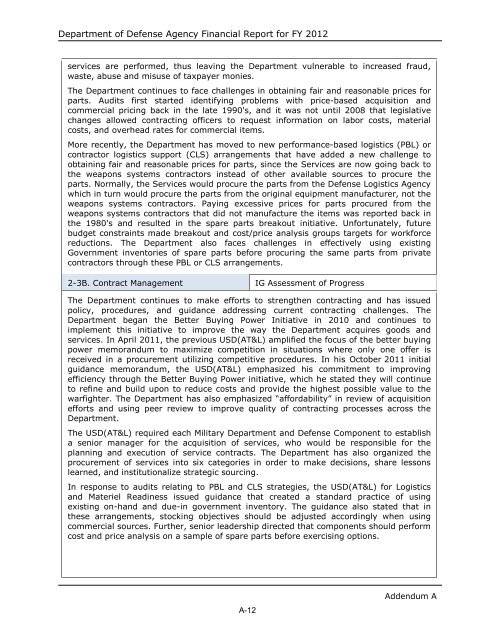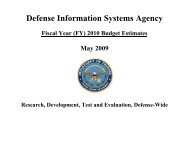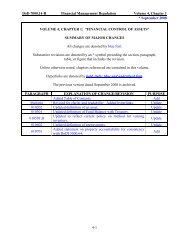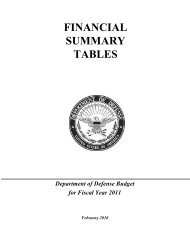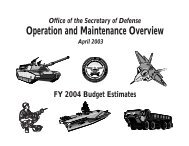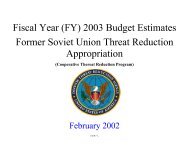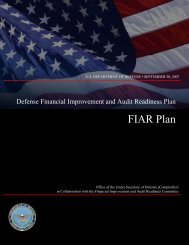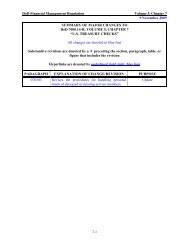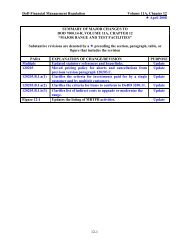department of defense agency financial report fiscal year 2012
department of defense agency financial report fiscal year 2012
department of defense agency financial report fiscal year 2012
You also want an ePaper? Increase the reach of your titles
YUMPU automatically turns print PDFs into web optimized ePapers that Google loves.
Department <strong>of</strong> Defense Agency Financial Report for FY <strong>2012</strong><br />
services are performed, thus leaving the Department vulnerable to increased fraud,<br />
waste, abuse and misuse <strong>of</strong> taxpayer monies.<br />
The Department continues to face challenges in obtaining fair and reasonable prices for<br />
parts. Audits first started identifying problems with price-based acquisition and<br />
commercial pricing back in the late 1990's, and it was not until 2008 that legislative<br />
changes allowed contracting <strong>of</strong>ficers to request information on labor costs, material<br />
costs, and overhead rates for commercial items.<br />
More recently, the Department has moved to new performance-based logistics (PBL) or<br />
contractor logistics support (CLS) arrangements that have added a new challenge to<br />
obtaining fair and reasonable prices for parts, since the Services are now going back to<br />
the weapons systems contractors instead <strong>of</strong> other available sources to procure the<br />
parts. Normally, the Services would procure the parts from the Defense Logistics Agency<br />
which in turn would procure the parts from the original equipment manufacturer, not the<br />
weapons systems contractors. Paying excessive prices for parts procured from the<br />
weapons systems contractors that did not manufacture the items was <strong>report</strong>ed back in<br />
the 1980's and resulted in the spare parts breakout initiative. Unfortunately, future<br />
budget constraints made breakout and cost/price analysis groups targets for workforce<br />
reductions. The Department also faces challenges in effectively using existing<br />
Government inventories <strong>of</strong> spare parts before procuring the same parts from private<br />
contractors through these PBL or CLS arrangements.<br />
2-3B. Contract Management IG Assessment <strong>of</strong> Progress<br />
The Department continues to make efforts to strengthen contracting and has issued<br />
policy, procedures, and guidance addressing current contracting challenges. The<br />
Department began the Better Buying Power Initiative in 2010 and continues to<br />
implement this initiative to improve the way the Department acquires goods and<br />
services. In April 2011, the previous USD(AT&L) amplified the focus <strong>of</strong> the better buying<br />
power memorandum to maximize competition in situations where only one <strong>of</strong>fer is<br />
received in a procurement utilizing competitive procedures. In his October 2011 initial<br />
guidance memorandum, the USD(AT&L) emphasized his commitment to improving<br />
efficiency through the Better Buying Power initiative, which he stated they will continue<br />
to refine and build upon to reduce costs and provide the highest possible value to the<br />
warfighter. The Department has also emphasized “affordability” in review <strong>of</strong> acquisition<br />
efforts and using peer review to improve quality <strong>of</strong> contracting processes across the<br />
Department.<br />
The USD(AT&L) required each Military Department and Defense Component to establish<br />
a senior manager for the acquisition <strong>of</strong> services, who would be responsible for the<br />
planning and execution <strong>of</strong> service contracts. The Department has also organized the<br />
procurement <strong>of</strong> services into six categories in order to make decisions, share lessons<br />
learned, and institutionalize strategic sourcing.<br />
In response to audits relating to PBL and CLS strategies, the USD(AT&L) for Logistics<br />
and Materiel Readiness issued guidance that created a standard practice <strong>of</strong> using<br />
existing on-hand and due-in government inventory. The guidance also stated that in<br />
these arrangements, stocking objectives should be adjusted accordingly when using<br />
commercial sources. Further, senior leadership directed that components should perform<br />
cost and price analysis on a sample <strong>of</strong> spare parts before exercising options.<br />
A-12<br />
Addendum A


